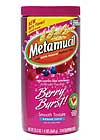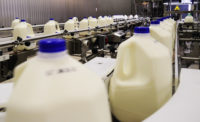

If memory serves me right, the dairy industry has long been of the opinion that Americans just don’t want to talk about “that stuff.” This excuse has prevented probiotic marketers from touting the benefits of these good-for-your-gut cultures.
But this column is not about probiotics; it’s on fiber. Dairy foods marketers looking to include fiber in their products should take note of Cincinnati-based Procter & Gamble’s approach in marketing sugar-free Berry Burst! Metamucil. The company describes this powder mix that’s to be stirred into water, as a product that will help Americans get gorgeous guts. Like all Metamucil products, the flavor contains 100% fiber from psyllium husk.
Despite the fact that beauty has historically been viewed as what someone possesses on the outside, the truth is that part of looking good is feeling good on the inside as well. To maintain gorgeous guts, the National Academy of Science suggests that Americans consume 21 to 38 grams of total fiber each day; however, the average American consumes only 10 to 15 grams.
Fiber is classified as being soluble or insoluble. Soluble fiber, as found in Metamucil, may form a gel in the stomach, entrapping food, sugars, cholesterol and fats before carrying them through the digestive tract and disposing of them. Some soluble fibers have also been shown to boost calcium absorption and act as prebiotics to promote the growth of probiotics. Many soluble fiber ingredients contain fructooligosaccharide, gum, inulin, pectin, polydextrose or resistant maltodextrin.
Fiber ingredients described as insoluble often contain cellulose, hemicellulose, lignin or resistant starch. Insoluble fiber is associated with reducing the risk of digestive disorders, as well as certain cancers. The insoluble fiber adds bulk to stool. This speeds transit time through the lower intestines, getting undesirables out of the body a little bit quicker.
There are many more benefits associated with specific fiber ingredients, which is some of the basis for the current mayhem in the regulatory world.
Although a definition already exists, a new proposed, more limiting definition for the term fiber is currently up for comment by the Codex Committee on Nutrition and Foods for Special Dietary Uses. If a new definition is adopted, many of today’s fiber ingredients would be assessed on their own individual merits and not bundled together under the broad umbrella of fiber.
The current definition is: “Dietary fiber means carbohydrate polymers with a degree of polymerization (DP) not lower than three, which are neither digested nor absorbed in the small intestine. A degree of polymerization not lower than three is intended to exclude mono- and disaccharides. It is not intended to reflect the average DP of a mixture.”
This definition allows for edible carbohydrate polymers naturally occurring in the food as consumed; carbohydrate polymers, which have been obtained from food raw material by physical, enzymatic or chemical means; and synthetic carbohydrate polymers.
Numerous scientists feel this definition of fiber is too broad, and that the definition of dietary fiber should be more clearly linked to fruits, vegetables and whole grain cereals. They propose the definition: “Dietary fiber consists of intrinsic plant cell wall polysaccharides.”
The justification is that epidemiological support for the health benefits of dietary fiber is based on diets containing fruits, vegetables and whole grain cereal foods, and therefore containing plant cell walls. They say that the plant cell wall is the food component that should form the basis of a dietary fiber definition, as it provides a consistent indicator of the plant foods promoted in dietary guidelines and intake has been used to establish population reference values for dietary fiber.
Using this approach, dietary fiber is defined as a natural food, meaning that most of today’s fiber ingredients that are added to foods and supplements would no longer be classified as fiber. In other words, the epidemiological base for dietary fiber-rich foods could not be extrapolated to foods enriched with fiber ingredients. Such ingredients would need to be researched on their own and, if shown to be beneficial to health, be promoted in their own right. Considering the variation in chemical and physiological properties involved, the best approach is to validate and if appropriate, establish health claims on an individual basis.
Although Codex Alimentarius has no force of law, it is often regarded as a standard by countries looking to draw up new food laws, and is also used by the WHO to settle trade disputes.
As my dad would say, “that gets my bowels in an uproar!”


